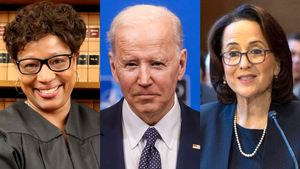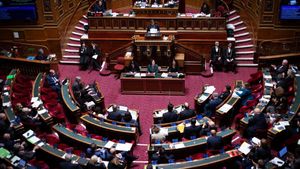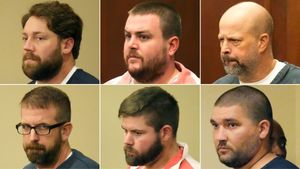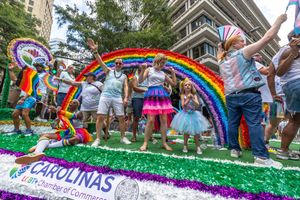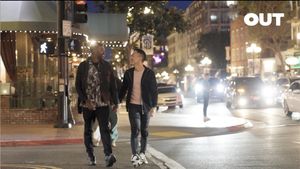Hate-crime
incidents rose nearly 8% last year, the FBI reported Monday,
as civil rights advocates increasingly take to the streets
to protest what they call official indifference to
intimidation and attacks against blacks and other
minorities.
Police across the
nation reported 7,722 criminal incidents in 2006
targeting victims or property as a result of bias against a
race, religion, sexual orientation, ethnic or national
origin, or physical or mental disability. That was up
7.8% from 7,163 incidents reported in 2005.
More than half
the incidents were motivated by racial prejudice, but the
report did not even pick up all the racially motivated
incidents last year.
Although the
noose incidents and beatings among students at Jena, La.,
high school occurred in the last half of 2006, they were not
included in the report. Only 12,600 of the nation's
more than 17,000 local, county, state, and federal
police agencies participated in the hate-crime
reporting program in 2006, and neither Jena nor LaSalle
Parish, in which the town is located, were among the
agencies reporting.
Nevertheless, the
Jena incidents, and a subsequent rash of noose and
other racial incidents around the country, have spawned
civil rights demonstrations that culminated last week
at Justice Department headquarters. The department
said it investigated the Jena incident but decided not
to prosecute because the federal government does not
typically bring hate-crime charges against juveniles.
Organizers said
100 busloads of protesters joined Friday's march in
Washington, D.C. In September, an estimated 20,000
protesters marched through Jena. On November 3,
hundreds of protesters marched through downtown
Charleston, W.Va., to urge prosecutors to add hate-crime
charges against six white people charged in the
beating, torture, and sexual assault of a 20-year-old
black woman who was discovered September 8 after
several days of alleged captivity in a rural trailer.
The Jena case
began in August 2006 after a black student sat under a tree
known as a gathering spot for white students. Three white
students later hung nooses from the tree. They were
suspended by the school but not prosecuted. Six black
teenagers, however, were charged by LaSalle Parish
prosecutor Reed Walters with attempted second-degree murder
of a white student who was beaten unconscious in
December 2006. The charges have since been reduced to
aggravated second-degree assault, but civil rights
protesters have complained that no charges were filed
against the white students who hung the nooses.
''The FBI report
confirms what we have been saying for many months about
the severe increase in hate crimes,'' said the Reverend Al
Sharpton, who organized Friday's march. ''What is not
reported, however, is the lack of prosecution and
serious investigation by the Justice Department to
counter this increase in hate crimes.'' Sharpton called for
Atty. Gen. Michael Mukasey to meet with members of the
Congressional Black Caucus and civil rights leaders to
discuss this enforcement.
Justice
Department spokesman Brian Roehrkasse noted that Mukasey
praised the civil rights movement at his confirmation
hearings and plans over the next several months to
meet ''with a number of groups and individuals who
have an interest in or concerns about the work'' of the
department. Roehrkasse also noted that federal
prosecutors convicted a record 189 defendants of civil
rights violations in the fiscal year that ended
September 30.
The Justice
Department says it is actively investigating a number of
noose incidents in schools, workplaces, and neighborhoods
around the country. It says ''a noose is a powerful
symbol of hate and racially motivated violence''
recalling the days of lynchings of blacks and that it
can constitute a federal civil rights offense under some
circumstances.
The FBI report
does not break out the number of noose incidents, but the
two most frequent hate crimes in 2006 were property damage
or vandalism, at 2,911 offenses, and intimidation, at
2,046 offenses. There were three murders, six rapes,
860 aggravated assaults, 1,447 simple assaults, and 41
arsons. Other offenses included robbery, burglary, larceny,
and motor vehicle theft.
The 7,722
hate-crime incidents involved 9,080 specific criminal
offenses, include 5,449 against individuals, 3,593
against property, and 38 classified as against society
at large. A single incident can be aimed at both
people and property.
Since the FBI
began collecting hate crime data in 1991, the most frequent
motivation has been racial bias, accounting for 51.8% of
incidents in 2006, down from the 54.7% in 2005.
Also in 2006,
religious bias was blamed for 18.9% of the incidents,
sexual orientation bias for 15.5%, and ethnic or national
origin for 12.7%.
''This FBI report
confirms ... that hate-crimes protections for the gay,
lesbian, bisexual, and transgender community are long
overdue,'' said Joe Solmonese, president of the Human
Rights Campaign, a civil rights group. Solmonese
called on Congress to pass pending legislation that would
expand the federal hate-crimes statute to cover crimes
motivated by sexual orientation. The law currently
covers only crimes based on race, color, religious, or
national origin.
Lack of full
participation by the more than 17,000 police agencies around
the nation somewhat undermines year-to-year comparisons.
For instance, in
2004, 12,711 agencies reported 7,649 incidents. In 2005
only 12,417 agencies reported and incidents dropped 6% to
7,163. But in 2006 agencies reporting rose to 12,620
and incidents climbed 7.8% to 7,722.
In 2006 police
identified 7,330 offenders -- 58.6% white, 20.6% black,
12.9% race unknown, and the rest other races. Thirty-one
percent of incidents occurred near residences, 18% on
roads, 12.2% at colleges or schools, 6.1% in parking
lots or garages, 3.9% at churches, synagogues, or
temples, and the remainder elsewhere. (Michael Sniffen, AP)





















